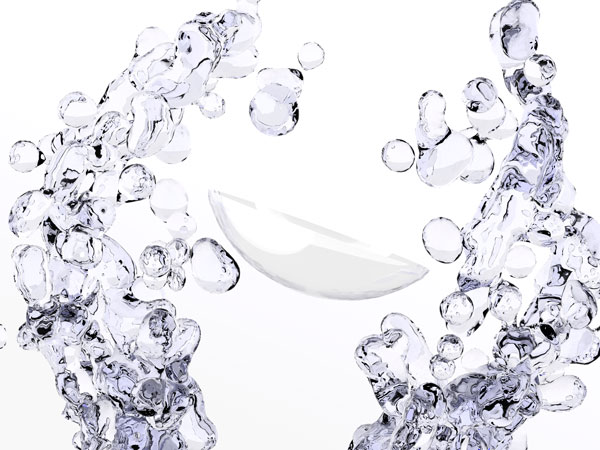Want to know how silicone hydrogels make contact lenses better? We take a comprehensive look into what they offer, and how they make a difference to one’s vision
Contact lenses have progressed as the optical industry continues to develop better technology and materials. Over the past decade, Silicon Hydrogel has established itself as the preferred material in contact lenses worldwide. The usage of silicone hydrogel in lenses is aimed at increasing the oxygen permeability, wettability (better comfort) and clinical performance of contact lenses. Hence, silicone hydrogel contact lenses are a breath of fresh air for the patients’ eyes … literally!

A Look Back
Soft contact lenses were made possible in the 1960s, when young Czech chemist Otto Wichterle, along with his colleague Drahoslav Lim, produced hydroxyethyl methacrylate or HEMA. Wichterle thought HEMA might be a suitable material for contact lenses and gained his first patent for soft contact lenses. Over 100 lenses were produced by spin casting, and by 1965, more than 3,000 patients in Czechoslovakia were believed to be wearing soft lenses.
By 1970s, ‘water-loving’ polymers, cross-linked materials absorbing large quantities of water without dissolving, had developed. Called ‘hydrogels’, their softness and the capacity to store water made them unique. In 1999, major changes came about with the arrival of two silicone hydrogels – the PureVision lens (Bausch + Lomb) in 1999 (UK) and the Focus Night & Day lens (Alcon, formerly CIBA Vision). Popular brands of silicone hydrogel contact lenses include Acuvue Oasys (Vistakon – Johnson and Johnson), Air Optix Aqua (Alcon), Biofinity (CooperVision) and PureVision2 (Bausch + Lomb).
The Benefits
Contact lens materials must permit the transmission of both oxygen and ions. If the amount of oxygen reaching the cornea is significantly low (a state referred to as hypoxia), the wearer may suffer from red eyes, swollen corneas and blurred vision. Hypoxia can also increase the risk of developing an eye infection.
In silicone hydrogel materials, silicone rubber is combined with conventional hydrogel monomers. The silicone component of these lens materials provides extremely high oxygen permeability, while the hydrogel component facilitates flexibility, wettability and fluid transport, thereby aiding lens movement. Silicone has higher oxygen permeability, allowing more oxygen to pass than water, so oxygen permeability is no longer tied to how much water is in each lens. Silicone hydrogel and regular hydrogel lenses become deformed, hard and fragile when dry, but readily absorb water and become soft and gel-like when hydrated.

Silicone hydrogel contact lenses are healthier than conventional soft lenses because they allow up to six times more oxygen to pass through them. The increased oxygen transmission results in better overall eye health. This means they are ideal for those who wear their lenses for long periods of time, or who work under a range of conditions that aggravate the eye.
Today, silicone hydrogel contact lenses can correct both, short-sightedness and long-sightedness. They are also available as multifocals and for correcting astigmatism (toric lenses).
Types of Silicone Hydrogel Contact Lenses
Most varieties of silicone hydrogel contacts are disposable. However, not all silicone hydrogel lenses are the regular 30-day wear lenses. Some are weekly replacement lenses while others are daily wear lenses.
There are many types of silicone hydrogels used to manufacture contact lenses, that address different corrective and wearing needs. Silicon hydrogen gels have evolved into first, second and third generation contact lenses. Each contact lens, whatever the material, is US FDA-approved, or cleared for specific wear and replacement conditions.
Are They Right For Your Customers?
Every person is different, and so are their eyes. With silicone hydrogel contact lenses, some people may experience more lens awareness than when wearing regular hydrogel lenses.
Many silicone hydrogels have a much higher modulus than conventional hydrogel contact lenses. In addition to a possible foreign body sensation due to a stiffer material, this characteristic may result in minor edge-lift issues, if the material is too loose.
Silicone hydrogel contacts have lower mechanical strength, meaning that they cannot easily withstand the application of outside forces. So when one tries to pick up a hydrogel lens with their fingers, it will often temporarily lose its shape, and in a worst-case scenario, can tear. This makes them more difficult to handle in comparison to their hard counterparts.

The performance of silicone hydrogel contact lenses, despite their high levels of air permeability, performance is not upto the expected standard when it comes to contamination. Hence, they are more likely to cause infection than their traditional counterparts. Contamination may lead to formation of superior epithelial arcuate lesions (SEALs), which are splits in the eye’s epithelium, and contact lens–related papillary conjunctivitis (CLPC). This is a condition wherein the thin tissue known as ‘conjunctiva’ swells in the white parts, or sclera, of the eye.
Also, in some cases, the silicone material tends to attract more lipid deposits, which may cause blurred vision and discomfort. Some contact lens solutions may be less effective on silicone hydrogel lenses than they are on regular soft lenses.
The Products
Most eye doctors believe that within the next five years, more patients will be wearing silicone hydrogel lenses than any other lens material. Following are some noteworthy brands of silicone hydrogel lenses available*:
- Bausch + Lomb’s PureVision2 HD silicone hydrogel contact lenses with high definition optics are designed to reduce halos and glare and deliver clear, crisp vision. With a thin, rounded edge, PureVision2 HD is one of the thinnest lenses on the market today, yet it is remarkably easy to handle.
- Johnson & Johnson Vision Care’s Acuvue Oasys contact lenses are designed with its revolutionary patented wetting technology, HYDRACLEAR®Plus, which makes lenses ultra-smooth and wettable. 1-DAY ACUVUE® TruEye® is the world’s first silicone hydrogel daily disposable lens. Acuvue Advanced for Astigmatism is a toric (astigmatism correcting) silicone hydrogel lens.
- Alcon’s AIR OPTIX® COLORS prescription contact lenses, which is a coloured contact lens that encapsulates Alcon’s 3-in-1 colour technology in a silicone hydrogel lens.
- CooperVision’s Avaira series features a combination of unique material technologies that let eyes breathe and stay moist naturally for continuous comfort throughout the day. As an added benefit, they also help block harmful UV rays. Furthermore, they are suitable for everybody, even if they are nearsighted, farsighted or need contacts for astigmatism.
- Sauflon launched the innovative ‘clariti 1day’ silicone hydrogel contact lenses that allow eye care practitioners to upgrade more patients to the most convenient contact lens modality at little or no additional cost.
There are many different types of silicone hydrogel materials, that aid in addressing different corrective and wearing needs.

It’s important to know the customer’s specific needs with regard to overnight or extended wear, before checking whether it is cleared for specific wear and replacement conditions.
Why Silicone Hydrogel Lenses?
The primary benefit of silicone hydrogel lenses is that they increase oxygen permeability and wettability. This opens up many possibilities for contact lens wearers, including :
- Extended wear (sometimes for up to six straight days and nights)
- Continuous wear (sometimes for up to 30 days before replacement)
- Increased comfort and better performance












